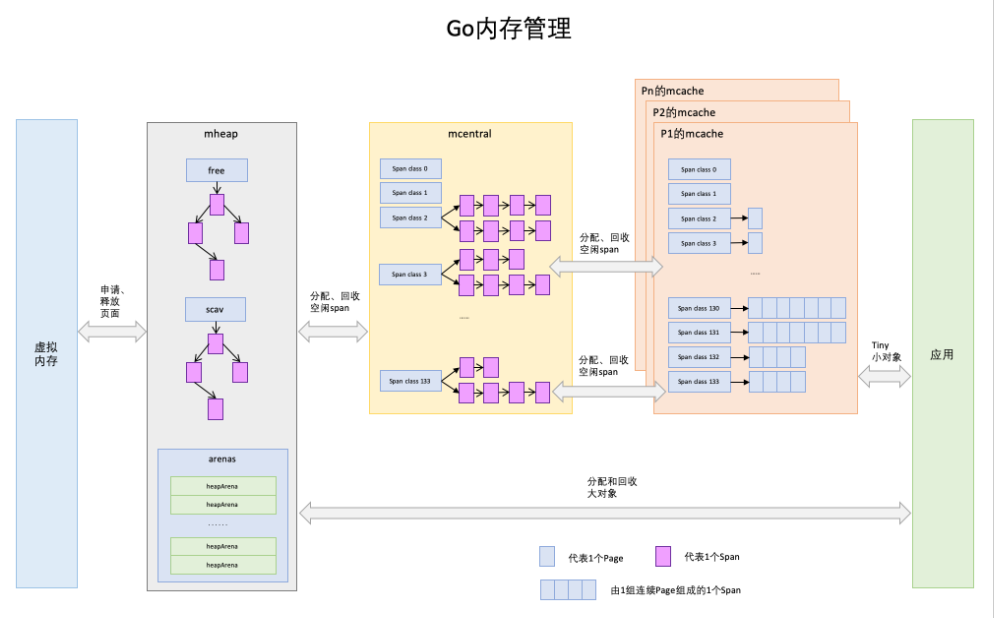楔子
读《Go语言学习笔记》下卷
粗读一遍,记录下值得所关注以及记忆的内容。较少涉及汇编内容。
本文整理过程中可能包含了不同版本的源码,1.5.1、1.16。
init
初始化过程中,会涉及到内存分配、垃圾回收器、并发调度器的初始化,还有诸如调度器、环境变量、调试信号等等。这些运行时的初始化完毕后,进而执行runtime.main 。其中会定义执行栈、系统后台监控(GC、并发调度任务)、垃圾回收器后台操作。
值得开发者注意的是包初始化函数的执行。
与此相关的就是runtime_init和main_init。这两个函数均由编译器动态生成。
runtime和main内的多个init函数被赋予唯一的符号名,再由runtime.init和main.init今天统一调用。
同时zversion.go也是动态生成的,用来定义一些版本信息等。
main内的init函数主要用于调用lib以及被引用的包。
最后需要记住:所有init函数都会在同一个goroutine内进行;所有init函数结束后才会执行main.main
内存管理
前置知识
我们知道,程序运行时,内存大致是这样排布的。
←高地址方向
| 内核段 | 栈空间段 | 空闲 | 动态链接库 | 空闲 | 堆空间段 | 数据段 | 代码段 | 保留 |- 栈由高地址向低地址增长。
- 堆由低地址向高地址增长。
这里讲的地址空间段,是在虚拟地址空间内的。
进程内存空间的大小不等的分段,会被操作系统的分页机制,拆分成大小相等的页(Page)。
大小相等的(虚拟)页,会被打散到物理地址空间内的(物理)页上。
虚拟到物理,这个过程对于进程来说是不关心的,由操作系统进行调度。
下文中所述的内存空间,内存页,内存段,均以虚拟地址空间为标准。
分配
由于Golang内置运行时,故会抛弃传统的内存分配方式,避开系统调用带来的性能问题,也为了更好的处理GC问题。
Golang的内存分配基本策略如下:
- 每次申请一大块内存,减少小对象操作时的频繁系统调用。
- 大块内存切分,形成链表
- 分配内存时,从链表上取合适的一小块即可。
- GC时,归还到链表上。
- 若链表过大,尝试归还内存。
基本流程就是申请一块大的进行自我管理,按需归还。
TIPS:内存管理不关心对象状态,只有对象被回收后,才会触发内存回收。
Page
- Linux中,内存的最小粒度是4KB,分配内存最小4KB起。
- Golang里面一个Page是8KB。
Span
Span是Golang内存管理的基本单位,每个Span管理指定规格(以Page计)的内存块,且页地址连续。Span大小一定是8KB的整数倍。一共有67种规格的Span。
//from runtime.go\sizeclasses.go
// class bytes/obj bytes/span objects tail waste max waste
// 1 8 8192 1024 0 87.50%
// 2 16 8192 512 0 43.75%
//~~~~~~~~~~~~~~~~~~~~~~~~~~~~~~~~~~~~~~~~~~~~~~~~~~~~~~~~~~~~~~
// 65 28672 57344 2 0 4.91%
// 66 32768 32768 1 0 12.50%上述列出了66种不同的Span
- 如ID为1的Span:Object大小是8b(
class_to_size[1]=8);Span大小是8KB,为1页(class_to_allocnpages[1]=1);该Span内可存放1024个Object。 - Object最大为32KB,对于大于32KB的对象(大对象),会被区别对待,Class ID为0。
- Span结构体中
mspan存储了起始页号、页数、待分配Object链表等信息,而mspan之间以双向链表结构进行连接
type mspan struct {
next *mspan // next span in list, or nil if none
prev *mspan // previous span in list, or nil if none
list *mSpanList // For debugging. TODO: Remove.
startAddr uintptr // address of first byte of span aka s.base()
npages uintptr // number of pages in span
manualFreeList gclinkptr // list of free objects in mSpanManual spans
// Object n starts at address n*elemsize + (start << pageShift).
freeindex uintptr
nelems uintptr // number of object in the span.
allocCache uint64
allocBits *gcBits
gcmarkBits *gcBits
// sweep generation:
// if sweepgen == h->sweepgen - 2, the span needs sweeping
// if sweepgen == h->sweepgen - 1, the span is currently being swept
// if sweepgen == h->sweepgen, the span is swept and ready to use
// if sweepgen == h->sweepgen + 1, the span was cached before sweep began and is still cached, and needs sweeping
// if sweepgen == h->sweepgen + 3, the span was swept and then cached and is still cached
// h->sweepgen is incremented by 2 after every GC
sweepgen uint32
divMul uint16 // for divide by elemsize - divMagic.mul
baseMask uint16 // if non-0, elemsize is a power of 2, & this will get object allocation base
allocCount uint16 // number of allocated objects
spanclass spanClass // size class and noscan (uint8)
state mSpanStateBox // mSpanInUse etc; accessed atomically (get/set methods)
needzero uint8 // needs to be zeroed before allocation
divShift uint8 // for divide by elemsize - divMagic.shift
divShift2 uint8 // for divide by elemsize - divMagic.shift2
elemsize uintptr // computed from sizeclass or from npages
limit uintptr // end of data in span
speciallock mutex // guards specials list
specials *special // linked list of special records sorted by offset.
}Object
Span章节种讲到了Object。
讲Span按照特定大小切分(见表),每个小块即存储一个Object。
mCache
每一个Runtime的工作线程(M),会有一个mcache,由于是一个线程和一个mcache对应,故mcache无需加锁。工作线程(M)通过mcache管理每个GoRoutine(G)需要的内存,即从mcache中获取空闲Span。
根据分配对象的大小,内部会使用不同的内存分配机制,详细参考函数 mallocgo()
<16B会使用微小对象内存分配器,主要使用mcache.tinyXXX这类的字段16B-32KB从P下面的mcache中分配>32KB直接从mheap中分配(大对象)
type mcache struct {
nextSample uintptr
scanAlloc uintptr
//小对象
tiny uintptr
tinyoffset uintptr
tinyAllocs uintptr
// 16B-32KB大小对象的存储之处,所以Class ID为0的Span不可能存在这里
alloc [numSpanClasses]*mspan
stackcache [_NumStackOrders]stackfreelist //每个 G 绑定的栈空间
flushGen uint32
}- 每个
span存两次,一个不包含指针的对象列表和另一个包含指针的对象列表。这种区别将使垃圾收集的工作更容易,因为它不必扫描不包含任何指针的范围。 - 第一组span对象中包含了指针,叫做scan,表示需要gc scan;第二组没有指针,叫做noscan。提高gc scan性能。
- mcache初始没有span,G先从central动态申请span,并缓存在cache。
Central
按Span class对Span分类,串联成链表,当mcache的某个级别Span的内存被分配光时,它会向mcentral申请1个当前级别的Span。所有线程共享的缓存,会有多个线程访问central,故需要加锁访问。
//go 1.16
type mcentral struct {
spanclass spanClass //(uint8)
partial [2]spanSet // list of spans with a free object
full [2]spanSet // list of spans with no free objects
}
type spanSet struct { //有点略像Slice的实现
spineLock mutex
spine unsafe.Pointer // *[N]*spanSetBlock, accessed atomically
spineLen uintptr // Spine array length, accessed atomically
spineCap uintptr // Spine array cap, accessed under lock
index headTailIndex
}每个mCentral包含两个spanSet
full:双向span链表,包括没有空闲对象的Span或缓存mCache中的Span。当此处的Span被释放时,它将被移至partial链表。partial:有空闲对象的span双向链表。当从mCentral请求新的Span,mCentral将从该链表中获取span并将其移入full链表。- Tips:在1.5.1版本里面,一个Central只有一个同步锁,上述代码选自1.16版本,我们可以看到同步锁粒度更小,猜测因此带来的性能更好。同时,原先的
mSpanList变成了spanSet。命名也发生了变化,个人觉得新版的源码使用full、partial相比empty和nonempty来说更易理解。
Heap
mCentral只管理特定的大小的Span,所以必然有一个更上层的数据结构,管理所有的central,这就是mheap。它把从OS申请出的内存页组织成Span,并保存起来。当mCentral的Span不够用时会向mHeap申请,mHeap的Span不够用时会向OS申请,向OS的内存申请是按页来的,然后把申请来的内存页生成Span组织起来,同样也是需要加锁访问的。大对象(>32KB)直接从mHeap上分配。
mHeap的结构相对比较复杂,每个Golang程序启动时候会向操作系统申请一块虚拟内存空间,但仅仅是虚拟内存空间,真正需要的时候才会发生缺页中断(OS层面),进而向系统申请真正的物理空间。在Golang1.11版本以后,申请的内存空间会放在一个heapArena数组里,由arenas [1 << arenaL1Bits]*[1 << arenaL2Bits]*heapArena表示,用于应用程序内存分配,根据源码公式,在64位非Windows系统分配大小是64MB,Windows 64位是4MB。
type mheap struct {
// lock must only be acquired on the system stack, otherwise a g
// could self-deadlock if its stack grows with the lock held.
lock mutex
pages pageAlloc // page allocation data structure
sweepgen uint32 // sweep generation, see comment in mspan; written during STW
sweepdone uint32 // all spans are swept
sweepers uint32 // number of active sweepone calls
allspans []*mspan // all spans out there
_ uint32 // align uint64 fields on 32-bit for atomics
pagesInUse uint64 // pages of spans in stats mSpanInUse; updated atomically
pagesSwept uint64 // pages swept this cycle; updated atomically
pagesSweptBasis uint64 // pagesSwept to use as the origin of the sweep ratio; updated atomically
sweepHeapLiveBasis uint64 // value of heap_live to use as the origin of sweep ratio; written with lock, read without
sweepPagesPerByte float64 // proportional sweep ratio; written with lock, read without
scavengeGoal uint64
reclaimIndex uint64
reclaimCredit uintptr
arenas [1 << arenaL1Bits]*[1 << arenaL2Bits]*heapArena
heapArenaAlloc linearAlloc
arenaHints *arenaHint
arena linearAlloc
allArenas []arenaIdx
sweepArenas []arenaIdx
markArenas []arenaIdx
curArena struct {
base, end uintptr
}
_ uint32 // ensure 64-bit alignment of central
central [numSpanClasses]struct {
mcentral mcentral
pad [cpu.CacheLinePadSize - unsafe.Sizeof(mcentral{})%cpu.CacheLinePadSize]byte
}
spanalloc fixalloc // allocator for span*
cachealloc fixalloc // allocator for mcache*
specialfinalizeralloc fixalloc // allocator for specialfinalizer*
specialprofilealloc fixalloc // allocator for specialprofile*
speciallock mutex // lock for special record allocators.
arenaHintAlloc fixalloc // allocator for arenaHints
unused *specialfinalizer // never set, just here to force the specialfinalizer type into DWARF
}分配规则
- tiny对象内存分配,直接向
mCache的tiny对象分配器申请,如果空间不足,则向mCache的tinySpanClass规格的span链表申请,如果没有,则向mCentral申请对应规格mSpan,依旧没有,则向mHeap申请,最后都用光则向操作系统申请。 - 小对象内存分配,先向本线程
mCache申请,发现mSpan没有空闲的空间,向mCentral申请对应规格的mSpan,如果mCentral对应规格没有,向mHeap申请对应页初始化新的mSpan,如果也没有,则向操作系统申请,分配页。 - 大对象内存分配,直接向
mHeap申请spanClassID=0,如果没有则向操作系统申请。
分配流程
- 计算对象规格(Size)
- 从
cache.alloc寻找对应规格的Span - 从
Span.manualFreeList提取可用Object - 若
Span空间不够,从Central获取新的Span - 如果
Central没有对应的Span,则从Heap中获取,并切分成Object链表。 - 如果
Heap中没有合适大小的Span,则向操作系统申请新内存块。
释放流程
- 标记可回收的
Object,归还给Span.manualFreeList。 Span被放回Central,可供任意Cache获取使用。- 若
Span已回收全部Object,则归还给Heap,以便重新切分复用。 - 定期扫描Heap中闲置Span,释放其占用内存。
其他
- 对于大对象,直接从
Heap中进行分配和回收。 - 不被共享的Cache是实现高性能的核心(没有锁)。Central是在多个Cache之间提高Object利用率,避免浪费。
- 回收操作会裁剪
Span中空闲的部分,归还给Central - Span最终归还给Heap是为了在不同规格的Object需求之间平衡。例如:某规格Object需求短时激增。

本文标题:Golang Runtime 内存模型
本文连接:https://blog.dextercai.com/archives/150.html
除另行说明,本站文字内容采用创作共用版权 CC-BY-NC-ND 4.0 许可协议,版权归本人所有。
除另行说明,本站图片内容版权归本人所有,未经许可前,严禁以任何形式的使用。

即日起视情况关闭全站评论区,您可以通过关于页面的电邮地址和我取得联系,谢谢